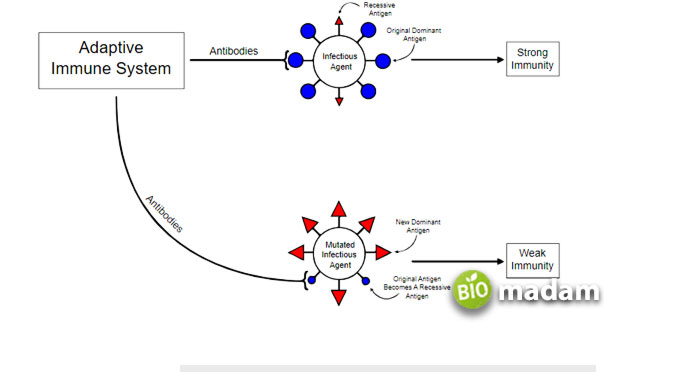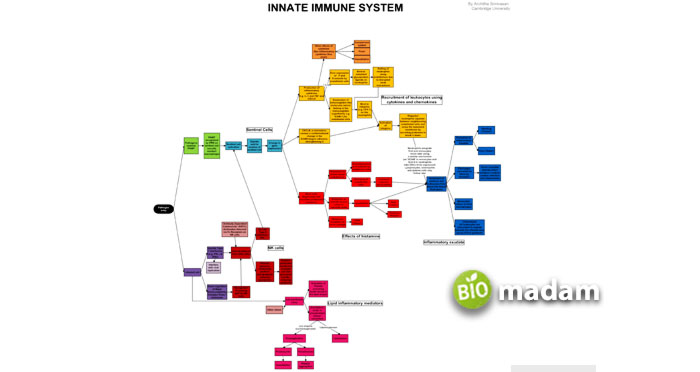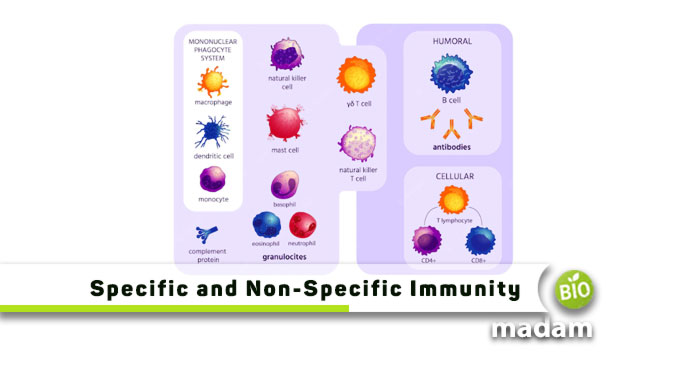Recently updated on April 6th, 2023 at 06:10 am
The immune system plays a fundamental role in protecting the body against antigens and pathogens. Various antibodies work together to fight off the disease-causing pathogens in the body. Each component contributes to a different type of immunity. Innate and adaptive immunity are the two basic types of immunity also known as specific and non-specific depending on the antigens they attack. Specific and non-specific immunity comprise unique components that contribute to the immune response.
Keep reading to learn more differences between specific and non-specific immunity.
Comparison Table
| Characteristics | Specific | Non-Specific |
| Definition | Specific antigen | All antigens |
| Part of | Adaptive immunity | Innate immunity |
| Effectiveness | Higher | Lower |
| Defense Line | Third line | First line |
| Components | Humoral and cell-mediated | Physical and chemical barriers, natural flora, complement proteins |
| Cells | APCs and lymphocytes | Neutrophils, T cells, mast cells, monocytes |
| Immunological Memory | Present | Absent |
What is Specific Immunity?
As the name indicates, specific immunity produces an immune response against a specific pathogen only.
Specific immunity is the body’s third line of defense, which activates when innate immunity fails to destroy the antigen. Various cells, including lymphocytes and antibodies, are involved in specific immunity. The surface receptors in lymphocytes bind to specific antigens through the secretion of specific proteins.
Helper T cells, cytotoxic T cells, and B cells contribute to the specific immune response produced by lymphocytes. They produce cell-mediated or humoral immunity. Macrophages act on the antigens through phagocytosis along with antigen-presenting cells and white blood cells. The antigen binding receptors MHC Type 1 and 2 crosslink with lymphocytes. This receptor cross-linkage activates lymphocytes which produce cytokines. They lead to the activation of B cells to develop antibodies that destroy antigens phagocytized previously. These substances are highly toxic microorganisms like bacteria and viruses.
Specific immunity takes place in two ways – the primary and the secondary response. The response takes a little more time when a foreign body interacts with the antibodies for the first time. This response is known as the primary response. On the other hand, once the primary response produces IgM, the B and T cells mature into memory cells to retain information about the antigen. IgG produces the secondary response based on the primary response by IgM. It skips the steps in the primary response and produces a much faster response than the primary response.

What is Non-Specific Immunity?
Non-specific immunity refers to an immune response against any type of antigen without prior exposure.
Compared to specific immunity, non-specific immune response is the first and the second line of defense. This response is generated by physical and chemical barriers of the body to prevent the entry of pathogens into the body. Physical barriers in the first line of defense include the skin, natural flora, and mucus layer. The skin contains glands like the sebaceous glands, which secrete sebum with antibacterial characteristics. Sweat also helps get rid of infections as the high salt content dries the microbes. The epithelial tissues in the body contain cilia that beat rhythmically to transport materials out of the body.
Tears, saliva, and stomach acids are chemical barriers to prevent the entrance of antigens. The second line of the defense comprises cells like neutrophils, natural killer cells, macrophages, dendritic cells, and mast cells that act as phagocytes to destroy foreign bodies. It leads to an allergic reaction in the form of histamine production, inflammation, and fever.

Similarities between Specific and Non-Specific Immunity
- Specific and non-specific immunity is part of the body’s defense mechanism.
- They prevent bacterial and viral infections in the body by acting against foreign particles.
- Both make use of white blood cells to avoid harm to the body by antigens.
Differences between Specific and Non-Specific Immunity
Definition
Specific Immunity
Specific immunity refers to the immune response produced against a specific antigen.
Non-Specific Immunity
Non-specific immunity produces an immediate response to protect the body against any antigen.
Part of
Specific Immunity
Specific immunity is a part of adaptive immunity in the immune system.
Non-Specific Immunity
Whereas non-specific immunity belongs to innate immunity.
Effectiveness
Specific Immunity
Specific immunity produces a more effective immune response against the pathogen.
Non-Specific Immunity
However, non-specific immunity produces a comparatively less effective immune response.
Defense Line
Specific Immunity
Specific immunity is the third line of defense of the body.
Non-Specific Immunity
At the same time, non-specific immunity acts as the body’s first or second line of defense.
Components
Specific Immunity
Specific immunity comprises the humoral and cell-mediated immune response.
Non-Specific Immunity
Alternatively, non-specific immunity consists of physical barriers, chemical barriers, phagocytes, natural flora, and complement proteins.
Involved Cells
Specific Immunity
Specific immunity uses antigen-presenting cells and lymphocytes to generate an immune response.
Non-Specific Immunity
While neutrophils, macrophages, T cells, mast cells, monocytes, and dendritic cells act in non-specific immunity.
Antibody Production
Specific Immunity
Specific immunity produces specific types of antibodies for that particular antigen.
Non-Specific Immunity
On the other hand, non-specific immunity produces mass antibodies instead of specific antibodies.
Memory
Specific Immunity
Specific immunity creates an immunological memory to identify the specific antigen.
Non-Specific Immunity
Conversely, non-specific immunity does not create a defensive memory of the antigen.
The Bottom Line
Specific and non-specific immunity are other names for adaptive and innate immunity. Non-specific immunity is the body’s first line of defense produced by physical and chemical barriers. Whereas specific immunity comprises immunoglobulins, macrophages, T-cells, B cells, mast cells, dendritic cells, etc. They contribute to the second or third line of defense. The main difference between specific and non-specific immunity is the production of antibodies. Specific immunity produces particular antibodies for an antigen, while non-specific immunity generates mass antibodies. Non-specific immunity also does not create an immunological memory of the antigen.
FAQs
What are the two main differences between specific and non-specific immune defenses?
Specific immunity produces an immune response through helper and killer cells, while non-specific immunity contributes through physical and chemical barriers. The specific immune system develops a defensive memory against the particular antigen.
What is an example of specific immunity?
Antibodies produced for an antigen will lead to specific immunity. For example, when coronavirus enters the body, it produces specific antibodies against SARS disease. These antibodies will protect you from getting reinfected with the virus by developing natural immunity for six to eight months.
What is an example of non-specific immunity?
Allergic responses are an example of non-specific immunity in the body exhibited through inflammation and fever.

Anna has completed her degree in Pharmacy from the University of Hawaii. She is serving as a research assistant in a pharmaceutical company. She had a great interest in writing blogs, traveling to different parts of the US, and trying delicious recipes in her spare time.

